The Buddhist Pure Land within the Dharma Hall: Canopy (Datjip)
Text by. Noh Seung-dae Photo by. Ha Ji-kwon
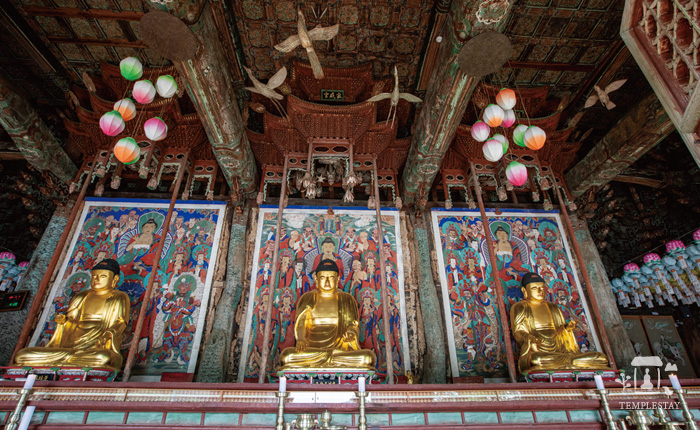 Daeungjeon Hall at Ssanggyesa Temple
Daeungjeon Hall at Ssanggyesa TempleThe Buddhist Canopy, a Symbol of Nobility
I enter the Great Hero Hall (Daeungjeon) of Ssanggyesa Temple in Nonsan. It is a large building 5 bays long and 3 bays deep. Captivated by the various floral patterns carved on its doors, I find it even more enchanting once inside. Splendid canopies have been carved above the heads of three buddhas, an unusual composition.
This Daeungjeon was originally a two-story building until the early 18th century. In 1736, a great fire broke out, and the temple was completely destroyed. In 1738, the Daeungjeon was rebuilt as a single-story building, which is the one we see today. The floor plan and building dimensions are the same as the temple before the fire; only the height has been reduced. The reason for this was that it was impossible to obtain tall wooden pillars to erect in the middle of the temple. It was difficult to obtain that many suitable wooden pillars at the time.
A similar situation occurred in 2001 when repairing Geunjeongjeon Hall in Gyeongbokgung Palace. American red pine was used because the main wooden pillars had to penetrate the first and second floors, and wooden pillars that size could not be found in Korea.
The Korean word for canopy is “datjip.” Because “dat” is an ancient word for “separate,” “datjip” is a “separate house” built inside a dharma hall. Some say it is called a “datjip” because it resembles a house hung from the ceiling. In any case, a canopy is a wooden structure that adorns a dharma hall, and it requires delicate craftsmanship. As a splendid decoration within a dharma hall, the canopy naturally has a long cultural history behind it.
When you see a great monk in a procession at a temple in Southeast Asia, you will also see an attendant following him with a large parasol to block the sun or to protect him from the rain. It is called an “ilsan” or “sangae (chattra)” because it blocks the sun. It is a symbol that serves to venerate a respected monk. This custom must have originated during the time of Shakyamuni Buddha, which is why parasols can be seen in Gandhara stone art.
After buddha statues began to appear in Buddhist art, the parasol that protected the Buddha morphed into a canopy that was suspended over these statues, and it became a symbol representing the Buddha’s virtues and achievements. It is called both the “bejeweled canopy (bogae),” because it is precious, and the “celestial canopy (cheongae)” because it appears to float in the air.
Usually, a canopy that appears as a decoration on top of a stupa enshrining the Buddha’s cremains is called the bejeweled canopy, and one that appears above the Buddha’s head in a Buddhist painting or above a stone buddha is called the celestial canopy, but both are symbols that originated from the parasol.
Naturally, this tradition entered the Silla Kingdom through China. One example is the Rock-Carved Buddhas (general treasure) in Tapgok Valley on Mt. Namsan in Gyeongju. Above the head of the buddha, sitting on a lotus pedestal between two pagodas, a splendid celestial canopy floating above the buddha is clearly engraved.
In this way, during the Silla period, buddha statues must have been placed in dharma halls with canopies above them, but there are no existing relics to confirm that. However, we can infer this through the Reliquary Case (a general treasure) discovered in the East Three-story Stone Pagoda at the Gameunsa Temple Site. Its inner case contains the sarira and has bamboo-shaped pillars at the four corners which support a splendidly decorated celestial canopy.
Also, if you look at the Seated Iron Medicine Buddha and Stone Pedestal (national treasure) in Janggoksa Temple in Cheongyang, the iron buddha was created during the Goryeo Dynasty, but the stone pedestal is from the Silla Dynasty. The square pedestal has a very wide stone base, and there are round grooves in the four corners where pillars once stood. This is evidence of the use of wooden pillars to support a celestial canopy.
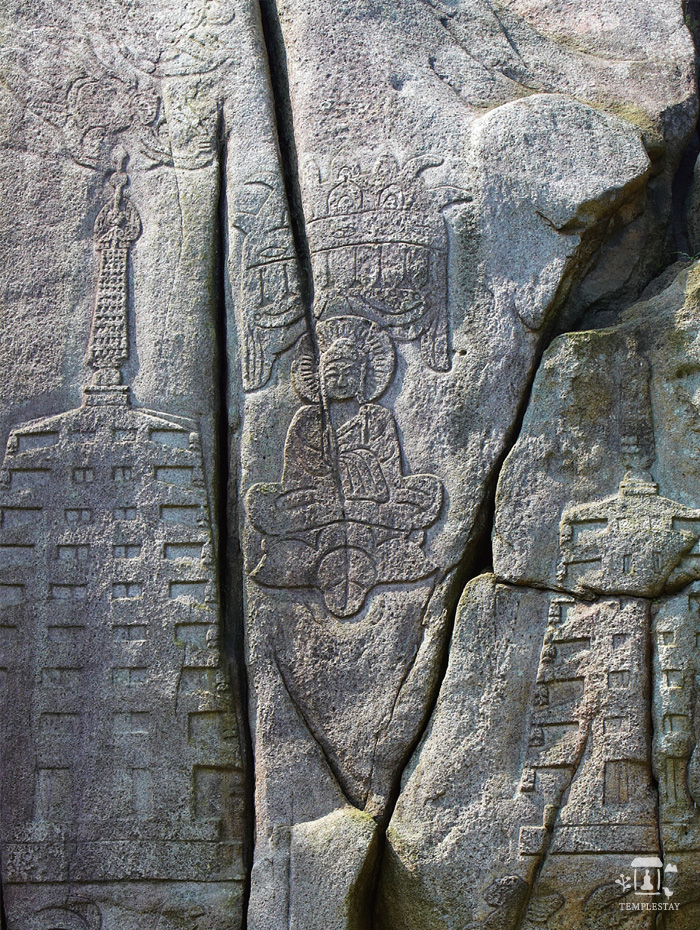 Rock-Carved Buddhas in Tapgok Valley
Rock-Carved Buddhas in Tapgok Valley
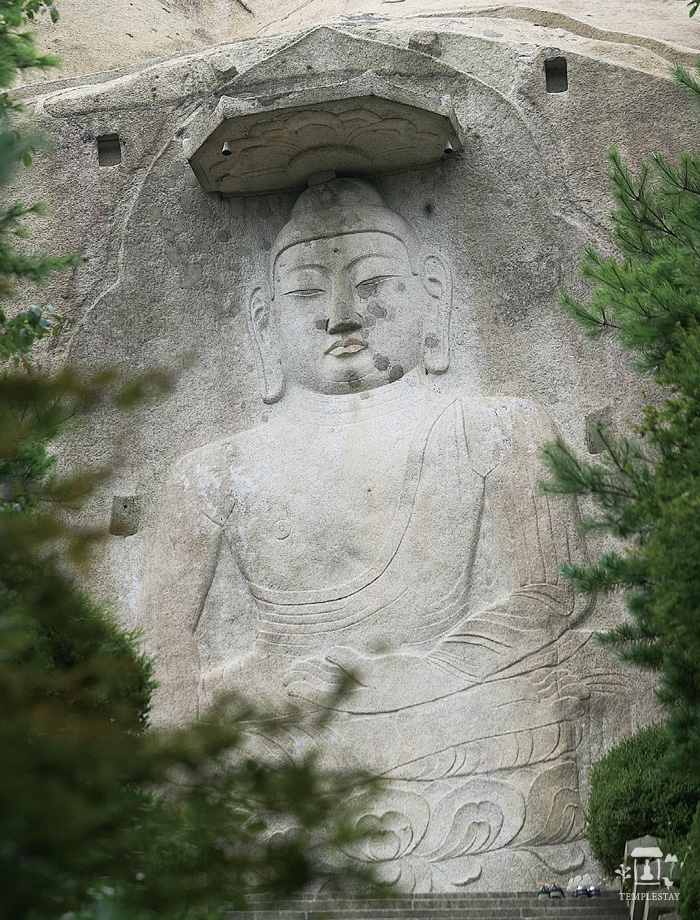 Seated Rock-Carved Buddha in Gugi-dong at Seunggasa Temple
Seated Rock-Carved Buddha in Gugi-dong at Seunggasa Temple
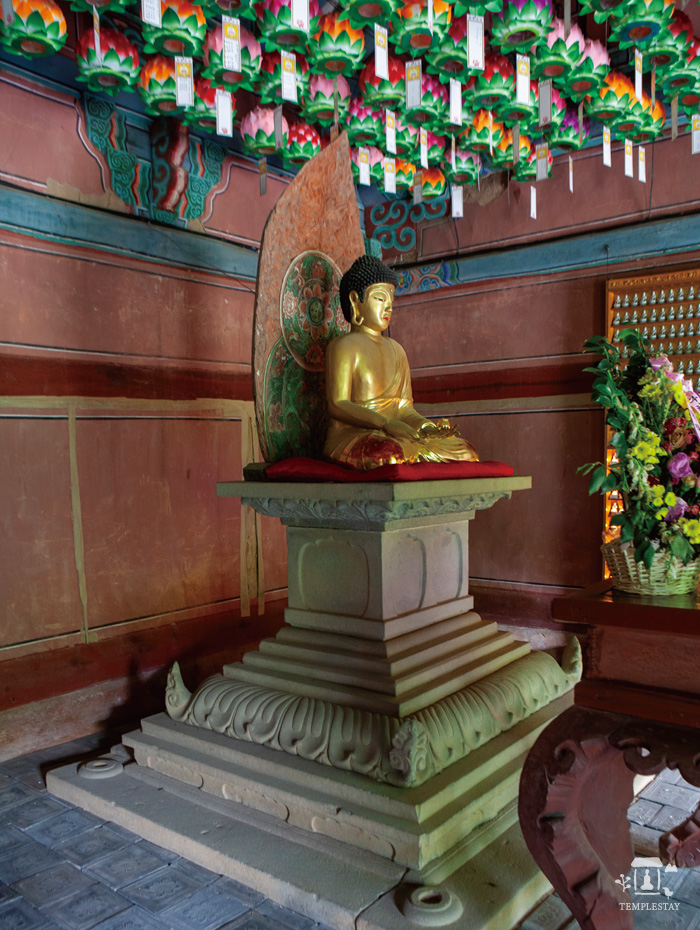 Seated Iron Medicine Buddha and Stone Pedestal in Janggoksa Temple
Seated Iron Medicine Buddha and Stone Pedestal in Janggoksa Temple
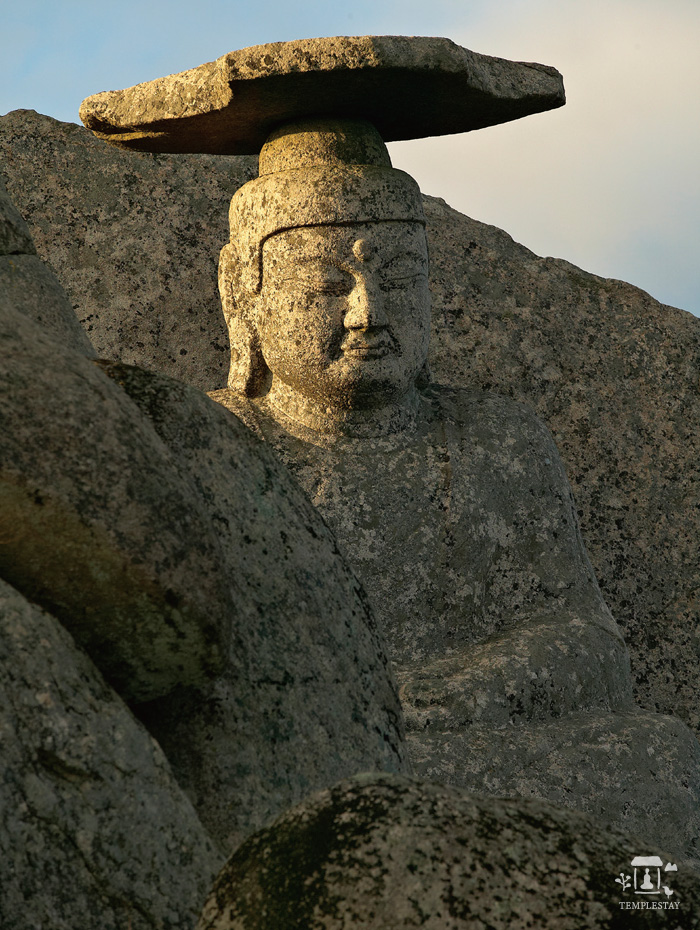 Gwanbong Seated Stone Buddha
Gwanbong Seated Stone Buddha
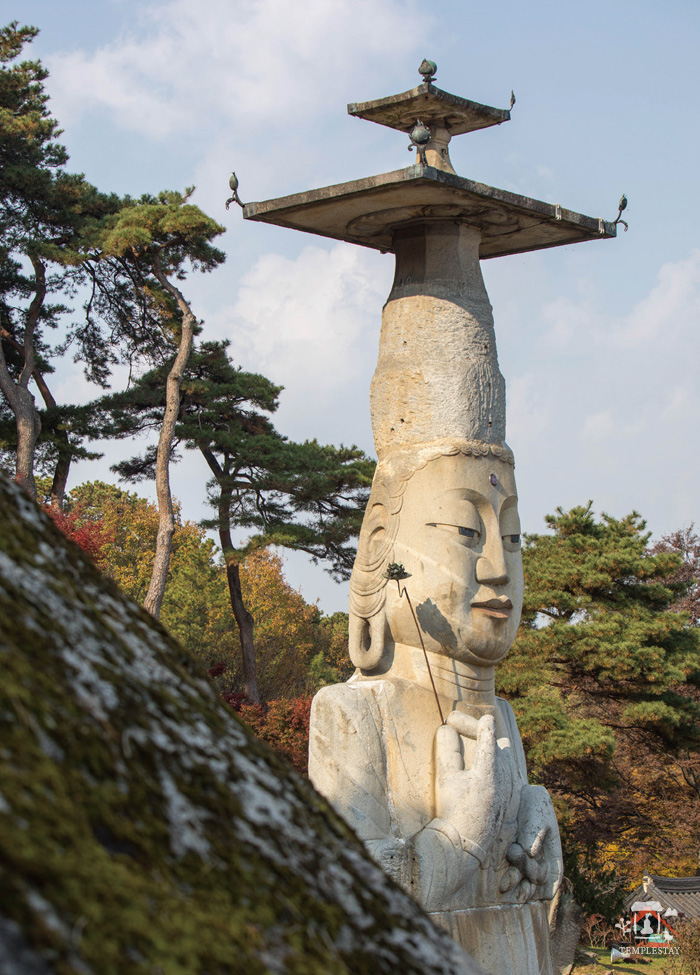 at Gwanchoksa Temple Eunjin Mireu
at Gwanchoksa Temple Eunjin Mireu
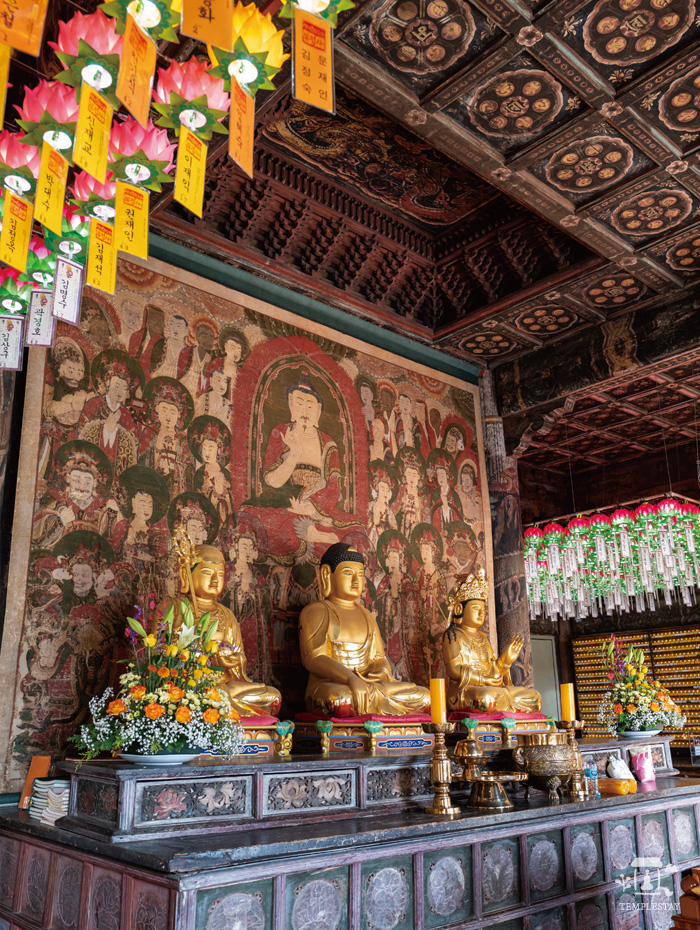 Daeungjeon Hall at Bongjeongsa Temple
Daeungjeon Hall at Bongjeongsa Temple
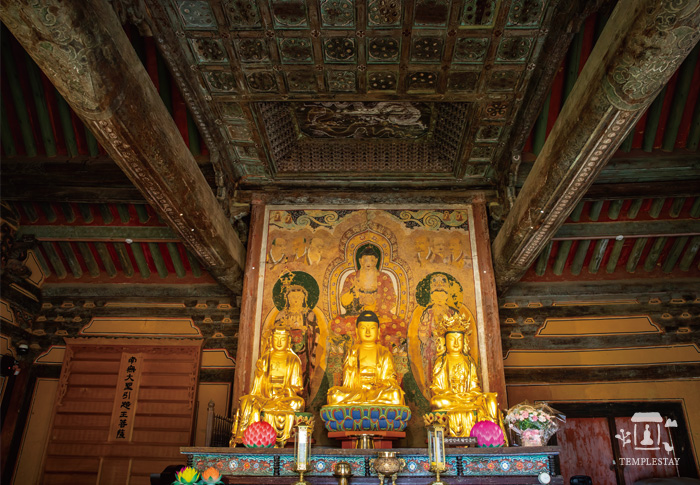 Paradise Hall at Muwisa Temple
Paradise Hall at Muwisa Temple
Various Styles of Canopies from the Goryeo Dynasty
In the Goryeo Dynasty, stone buddhas and rock-carved buddhas were created throughout the country. Naturally, celestial canopies appeared above buddhas enshrined outdoors. This is because when enshrined outdoors, a symbol to protect the buddha from sun, wind, and rain was even more necessary.
In the case of rock-carved buddhas, there were many cases where a wooden celestial canopy, created using the post and lintel system, was installed over the buddha’s head, such as the Rock-Carved Seated Buddha (general treasure) at the Dongburam Hermitage site of Seonunsa Temple in Gochang. But there were also cases where a precisely cut stone slab was inserted into the rock above the buddha’s head to symbolize the celestial canopy. This is seen in the Seated Rock-Carved Buddha in Gugi-dong (general treasure) at Seunggasa Temple on Mt. Bukhansan, Seoul, and at Daeseungsa Temple in Mungyeong.
However, there is a slightly more difficult problem in the case of free-standing stone buddha statues because a celestial canopy cannot be placed above the buddha’s head. However, it would not be appropriate to erect a precious buddha statue outdoors without a canopy, and that is why the practice of placing a stone celestial canopy over the buddha’s head emerged.
However, these stone canopies sometime look a bit awkward because they look like a bucket hat or a gat (Korean traditional hat made of bamboo and horsehair). The well-known Gatbawi Buddha on Mt. Palgongsan in Daegu is officially called Gwanbong Seated Stone Buddha (general treasure). The mountain peak is also called Gwanbong because this buddha statue wears what looks like a gat, but it is actually a celestial canopy. Since a celestial canopy cannot be suspended in the air, it was inevitably placed on top of the buddha’s head.
Stone buddhas enshrined outdoors during the Goryeo Dynasty usually have celestial canopies. Other symbols of celestial canopies are the crown-shaped decoration on the head of the Standing Stone Maitreya Bodhisattva at Gwanchoksa Temple in Nonsan (general treasure), commonly called Eunjin Mireuk, and the octagonal stone plate on top of the head of the Standing Stone Buddha (general treasure) at Mireuksa Temple Site in Chungju.
In Buddhist paintings and illustrated sutras of the Goryeo Dynasty, celestial canopies are always depicted. There is also a celestial canopy seen over the head of the buddha enshrined on the main altar in Geungnakjeon Hall (national treasure) at Bongjeongsa Temple in Andong. Pillars are erected at the four corners of the altar where Amitabha Buddha sits, and a celestial canopy formed of multiple brackets is placed on top. It shows that the celestial canopy is gradually changing to resemble more of a house. This altar is believed to have been built at the same time as Geungnakjeon Hall in 1361, the end of the Goryeo Dynasty, indicating that celestial canopies were changing in style toward the end of the Goryeo Dynasty.
The Birth of a Splendid Canopy
In the Joseon Dynasty, celestial canopies installed above the head of the buddha in the dharma hall were raised to the ceiling. This was often done by creating a rectangular space in the ceiling, in which brackets were installed, and a dragon was drawn in the center. This is called a bejeweled-style (bogae) canopy. Because it is recessed into the ceiling, it is also called a gamip canopy, and the ceiling itself is called a bogae ceiling. Examples of these are found in Daeungjeon Hall at Bongjeongsa Temple in Andong (national treasure) and in Paradise Hall at Muwisa Temple in Gangjin (national treasure). Both buildings date from the early Joseon Dynasty. Another style of canopy is the cloud palace-style (ungung) canopy. This refers to a canopy recessed into the ceiling above the head of the buddha. It is lined with wood and the inside is decorated with clouds, dragons, phoenixes, and flying celestials. The name originates from the fact that clouds are sometimes drawn or carved into the wooden lining. This style can be found in Daeungjeon at Gaesimsa Temple in Seosan (a general treasure) and in Daeungjeon at Hwanseongsa Temple in Gyeongsan (a general treasure).
The bejeweled canopy gradually evolved into the treasure palace-style (bogung) canopy, a unique structure with a roof placed on top of a bracket that gradually extended downward. This type of canopy is the most common one seen in temples today. Inside the treasure palace canopy is a three-dimensional full-body statue of a dragon. The standard is to place one dragon if there is one buddha, and three dragons if there are three buddhas. So, what is the background behind all these dragons? One story is found in the Mahavagga, part of the Vinaya Basket of Buddhist precepts. After Shakyamuni Buddha attained enlightenment, he stayed under a different tree for one week at a time, immersed in the joy of dharma. On the fifth week, he moved to a fifth tree, but from the first day, it rained heavily and was cold and stormy.
At that moment, Muchalinda, the snake king who lived under this tree, appeared and wrapped his body around Shakyamuni Buddha seven times and then shaded the Buddha’s head with his own hood. Muchalinda prayed to protect the Buddha so as not to disrupt his meditation and also to protect him from storms and insects.
After one week, the weather cleared and Muchalinda uncoiled his body from around the Buddha. Then, he suddenly shed his snake body, turned into a young Brahmin, and bowed to the Buddha with joined palms. If you visit Muchalinda Pond in Bodh Gaya, India, you can see a statue of the Buddha sitting on Muchalinda’s coiled body with his hood flared out to protect the Buddha from the elements. As Buddhism spread to Southeast Asia, depictions of Muchalinda, who became the protector of the Buddha, merged with belief in the Naga, the region’s god of water, and you can see it in paintings and sculptures in temples everywhere.
As time passed, Muchalinda became more and more divine, and the number of his heads increased to three, five, and finally seven, but Naga’s role as the guardian deity of the Buddha remained the same.
This myth of Naga Muchalinda was eventually transmitted to China and was replaced by an animal similar to the naga: the dragon, a guardian that protects the Buddha and the Buddha’s law. The dragon that we see in celestial canopies today is this guardian dragon, and its meaning is completely different from the dragon that symbolizes the king or emperor.
The Buddhist canopy originated from the parasol that protected the Buddha from the sun, and the guardian dragon originated from Muchalinda, who protected the Buddha from wind and rain. And that is how they came to coexist together inside the canopy.
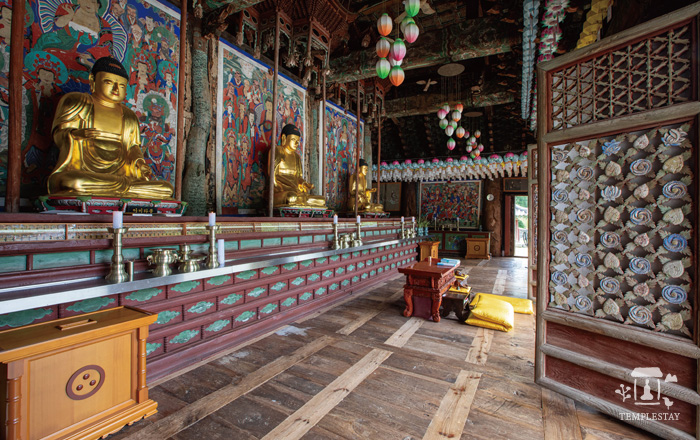 Daeungjeon Hall at Ssanggyesa Temple
Daeungjeon Hall at Ssanggyesa Temple
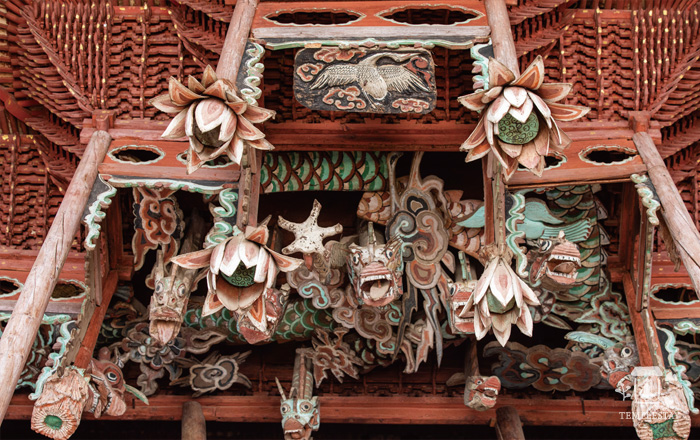 Daeungjeon Hall at Ssanggyesa Temple
Daeungjeon Hall at Ssanggyesa Temple
Buddhas Adorned with Palaces from Above
The treasure palace canopy is largely divided into two types. The “supporting pillar canopy” has auxiliary columns in front to support the weight of the canopy. The “hanging canopy” is suspended from a beam and does not use auxiliary columns.
The treasure palace canopy originated from the parasol, but gradually evolved into a form modeled after the palace in the Buddhist Pure Land, becoming a large, splendid structure to decorate the interior of a dharma hall. As canopies gradually increased in size, canopies appeared with double and triple roofs, and there were roof designs in the shape of the letters “亞” or “T.” They have changed in various ways, and each dharma hall has a canopy that differs from others in size, appearance, and feel.
Canopies are often decorated with flying cranes and birds of paradise, and flying celestials with billowing hems. Lotus flowers bloom and fall, fluttering in the wind. Even without words, we sense that this is the land of buddhas.
Daeungjeon Hall at Ssanggyesa Temple in Nonsan is renowned for its exquisite, classy canopies. As mentioned earlier, there is a canopy above each of the three buddhas in the dharma hall. It’s like having three palaces in one dharma hall, which is very rare. You can only see other examples in the Daeungjeon at Hwaeomsa Temple in Gurye (general treasure) and the Daeungjeon at Jikjisa Temple in Gimcheon (general treasure).
However, the canopies in the Daeungjeon at Hwaeomsa Temple are as high as a single-story, and the canopies in the Daeungjeon of Jikjisa Temple are cloud palace style canopies without brackets. The canopies in the Daeungjeon at Ssanggyesa Temple in Nonsan are double-story and in the shape of the Chinese character “亞.” They are magnificent and glorious structures boasting delicate craftmanship.
When facing the buddhas enshrined at Ssanggyesa Temple in Nonsan, from the left are Amitabha Buddha, Sakyamuni Buddha, and Medicine Buddha. This is the style that became popular after the Imjin War (Japanese invasion of Korea; 1592-1598). Amitabha Buddha was enshrined for those killed during that tragic war, Medicine Buddha for the sick and injured, and Sakyamuni Buddha for the survivors.
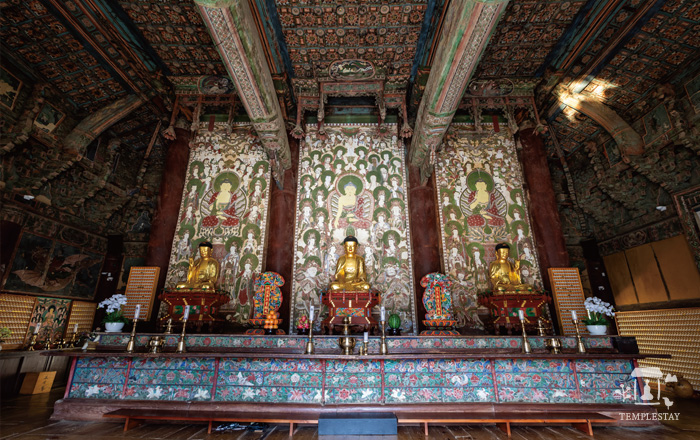 Daeungjeon at Jikjisa Temple
Daeungjeon at Jikjisa Temple
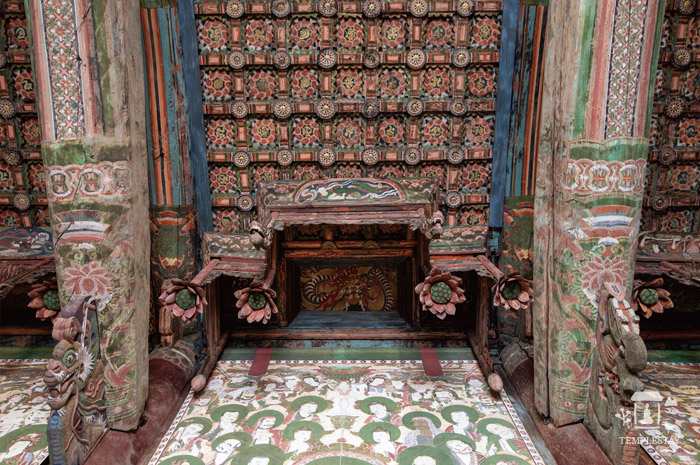 Daeungjeon at Jikjisa Temple
Daeungjeon at Jikjisa Temple
Because the canopy signifies the palace where each buddha resides, each canopy bears the name of their palace. The canopy over Amitabha Buddha has a plaque reading “Palace of Seven Jewels” because his paradise is adorned with seven treasures. The canopy over Shakyamuni Buddha has a plaque reading “Palace of Nirvana” because he entered nirvana, the realm where all afflictions cease to exist. The canopy over Medicine Buddha has a plaque reading “Full Moon Palace” because he resides in the world of the eastern full moon.
Cranes and birds of paradise are depicted flying around the canopy, symbols of auspiciousness. All three canopies have pillars suspended from the ceiling that extend down from the brackets, whose ends are decorated with lotus flowers. There are lotus buds and lotus seed pods, but only the canopy over Shakyamuni Buddha has four lotuses in full bloom, a symbol that Shakyamuni Buddha is the center of the dharma hall and that when the Buddha teaches, flowers rain down from the sky.
Inside each canopy one would expect to find one guardian dragon as in other dharma halls, but that is not the case. In the canopy over Shakyamuni Buddha there are nine. This is based on the story that when Shakyamuni Buddha was born into this world as Prince Siddhartha, water flowing from the mouths of nine dragons was used to bathe him. This nine-dragon canopy is only known to exist in this Daeungjeon Hall at Ssanggyesa Temple in Nonsan.
Another unique decoration here is the flame design carved on the eaves of the canopy, a design usually only seen on the head ornamentation of the Four Heavenly Kings. You can see the characters “om (ॐ)” and “卍” written inside it, both meaning it is a precious and sacred realm. As previously stated, the canopy originated as a parasol to protect the Buddha from the sun, but it later evolved into an important, magnificent structure that decorates the dharma hall, symbolizing the palaces where the buddhas reside.
There are no two identical canopies in ancient temples because they are works of art crafted with great devotion by master monks and Buddhist painters. We should take a new interest in them and strive to preserve them. They are made without nails as most wooden structures are; they are difficult to make, and once damaged, they are not easy to repair. That is why canopies are a precious Buddhist tradition.
Noh Seung-dae has devoted more than 20 years to visiting various sites and studying Korean cultural heritage with an unwavering passion for our culture. The results have been contributed to magazines like Bulkwang and People and Mountains . His Korean publications include Hidden Supporting Actors in Temples and At Temples Goblins Live and So Does Grandmother Samsin.
Check out more photos >




